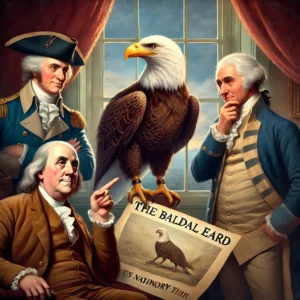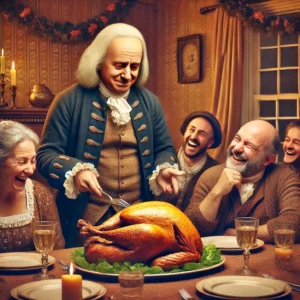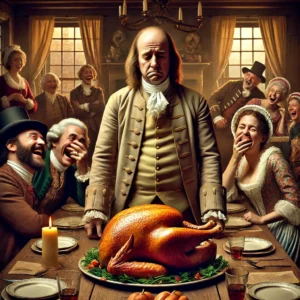
The Turkey Disaster: How Benjamin Franklin Almost Made the Turkey the National Bird
When America was just a young nation, one of the many decisions the Founding Fathers had to make was choosing a national symbol. Today, the bald eagle stands proudly as the emblem of the United States, but it almost didn’t turn out that way – thanks to Benjamin Franklin’s surprising affect
After the Revolutionary War, the Continental Congress tasked a committee, including Franklin, Thomas Jefferson, and John Adams, with designing a national seal that would symbolize America’s new identity. However, these men couldn’t agree on the best symbol. Many ideas were tossed around – scenes from Greek mythology, biblical references, even something involving Moses. But nothing quit

After some debate, an early proposal featuring the bald eagle emerged as a potential choice. The eagle, powerful and majestic, was admired by many for its fierce gaze and strong wings. Adams and Jefferson thought the eagle represented strength and resilience – fitting qualities for a new nation seeking resp
However, Franklin was less enthusiastic. He had spent years studying animals and saw the bald eagle as more of a “scavenger” than a noble creature. To Franklin, eagles had some unsavory habits: they often stole food from smaller birds rather than hunting on their own, and they were known to be aggressive, even bullying. Franklin considered these behaviors unworthy of a national symbol. He famously called the eagle a “bird of bad moral character.”
So, Franklin decided to make a case for an alternative: the turkey. According to Franklin, turkeys were much more fitting for America’s national identity. In his view, turkeys were brave – they would defend themselves when threatened, unlike the opportunistic eagle. A turkey, in Franklin’s eyes, was a “bird of courage,” standing its ground even against predators.

Franklin’s endorsement of the turkey sparked some raised eyebrows among his colleagues. Thomas Jefferson found it difficult to imagine America rallying behind a bird known more for being a dinner staple than a symbol of majesty. However, Franklin was undeterred, and he went so far as to write a letter to his daughter, Sarah, arguing that the bald eagle “is a bird of bad moral character.” In contrast, he said, “The turkey is in comparison a much more respectable bird.”
Yet, despite Franklin’s best efforts, the turkey did not win popular support. The image of a fierce eagle had already captured the American imagination, symbolizing the nation’s resilience and vision. And, frankly, many people found it hard to take Franklin’s turkey suggestion seriously, given that turkeys were more often seen in the kitchen than in nature.

In the end, the bald eagle became the official national bird in 1782, and Franklin’s vision of the turkey faded into history – though his turkey proposal has since become a famous tale of eccentricity and humor in American history.
Interestingly, Franklin never truly abandoned his fondness for turkeys. Legend has it that one Thanksgiving, he tried to prove to his family and friends just how noble turkeys could be by preparing a grand turkey dinner. Unfortunately, Franklin’s enthusiasm for the turkey as a noble bird didn’t translate to cooking skills, and the meal turned out to be a disaster, with a poorly cooked bird at the center of the feast. His family laughed, and Franklin had to admit defeat – at least in the kitchen.

Despite his failure to make the turkey the national bird, Franklin’s quirky and humorous idea remains a beloved part of American history. The story is a testament to Franklin’s unconventional thinking and his ability to see potential in the unexpected, even if his colleagues found it absurd. To this day, many Americans remember that their national bird could have been a turkey – a reminder that sometimes history hinges on humor and the unlikely opinions of brilliant minds like Benjamin Franklin.